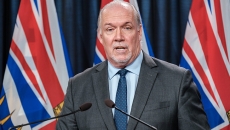The country's headline inflation meter jumped last month by 0.7 per cent compared to one year ago, the fastest the consumer price index has risen in months, largely on the back of higher food prices.
October's increase compared with a year-over-year rise of 0.5 per cent in September.
The increase was almost entirely driven by rising food prices, particularly lettuce and fresh or frozen chicken, Statistics Canada said Wednesday.
The 25.6 per cent annualized increase in the former was largely a result of supply issues. The 2.4 per cent growth in the latter had more to do with uncertainty in the food services industry, which continues to feel the brunt of the COVID-19 pandemic.
Natural gas prices rose by 11.6 per cent in October compared with the same month in 2019, driven mostly by a 12.5 per cent bump in Ontario.
Regionally, prices for cigarettes rose 14.9 per cent year-over-year in Newfoundland and Labrador, the largest increase since June 2003, on the back of a tax increase that kicked in Oct. 1.
The overall jump in October was the sharpest increase since June amid an eight-month spell where monthly readings have been under one per cent, held down by the change in shopping habits due to COVID-19.
Things aren't expected to get much better, even as retailers hope to entice shoppers into an earlier start to the Christmas shopping season.
BMO chief economist Douglas Porter said there will be a tug of war on prices as businesses balance increasing costs from public health measures while battling depressed demand.
Some sectors may see big price increases for hot items such as equipment for a home gym or outdoor furniture, but Porter said it won't be enough to drive up overall inflation.
"We've got a real push-and-pull on the inflation front," he said.
"We tend to believe that what is dominating and what will dominate overall is the underlying weakness in the economy and that will tend to keep a lid on overall inflation."
Statistics Canada noted gas prices were down 12.4 per cent in October compared to one year earlier. Excluding the drop from calculations, the headline inflation reading would have increased on a year-over-year basis of one per cent.
Statistics Canada said new home prices increased in October at their fastest pace in 14 years, as lower mortgage rates coincided with increased demand for single-family homes.
"While lower interest rates are reducing mortgage service costs, this is being overwhelmed by higher costs for new housing," James Marple, a senior economist with TD Economics, wrote in a note.
Mortgage rates have been driven down by the Bank of Canada's key policy rate — currently at 0.25 per cent — which is as low as the central bank says it can go. It says the rate will stay there until inflation is back at two per cent.
In October, the average of Canada’s three measures for core inflation, which are considered better gauges of underlying price pressures and closely tracked by the Bank of Canada, was about 1.8 per cent.
CIBC senior economist Royce Mendes said the core inflation readings suggest the relationship between consumer prices and the overall economy may be weaker than in the past.
That may force the central bank to leave stimulus in the economy for a little longer to help coax inflation back up to its comfort zone of two per cent, he wrote in a note.
The central bank forecasted last month that annual inflation would be 0.6 per cent this year, one per cent next year, and 1.7 per cent in 2022. The earliest the bank anticipates the economy would be able to handle higher rates is 2023.






